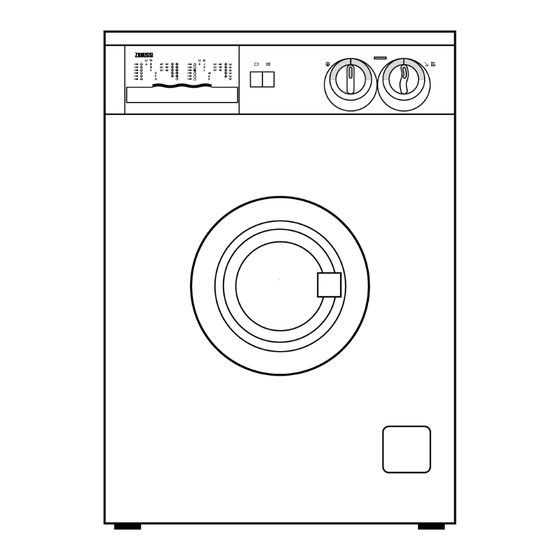
Summary of Contents for Zanussi F503
-
Page 1: Washing Machine
WASHING MACHINE LAVE-LINGE F 503 INSTRUCTION BOOKLET NOTICE D'UTILISATION 132997340... - Page 2 YOUR NEW WASHING MACHINE This new washing machine meets all Environment protection requirements for a modern washing of laundry with reduced consumption of water, energy and detergent. Packaging recycling The temperature selector dial allows you to Materials marked with the symbol are choose personally the suitable washing recyclable.
-
Page 3: Table Of Contents
CONTENTS Important information Maintenance ... . .4 ..... .16 Bodywork ......16 Description of the appliance . -
Page 4: Important Information
IMPORTANT INFORMATION It is important that this instruction book be kept with the appliance for future reference. If you sell or give the appliance away, make sure that the book is passed to the new owners so that they can familiarise themselves with its operation and relevant warnings. -
Page 5: Description Of The Appliance
DESCRIPTION OF THE APPLIANCE 1 Detergent dispenser drawer 2 Programme chart 3 Option buttons 40 °- 95 ° 30 °- 60 ° 30 °- 60 ° 30 °- 40 ° 30 °- 40 ° 30 °- 40 ° 4 Temperature selector dial 5 Operating pilot light 6 Programme selector dial / ON-OFF switch 7 Door handle... -
Page 6: Installation
INSTALLATION Unpacking All transit bolts and packing must be removed before using the appliance. You are advised to keep all transit devices so that they can be refitted if the machine ever has to be transported again. 1. Using a spanner, unscrew and remove the rear right-hand bolt and lay the machine on its back, taking care not to squash the hoses. -
Page 7: Water Inlet
Water inlet Connect the water inlet hose to a tap with a 3/4" thread. The other end of the inlet hose which connects to the machine can be turned in any direction. Simply loosen the fitting, rotate the hose and retighten the fitting, making sure there are no water leaks. -
Page 8: Use
Control panel 4 Temperature selector dial 1 Detergent dispenser drawer Turn this dial to select the washing temperature. 2 Half load button Position = cold wash. Select this button to reduce water consumption 5 Operating pilot light on the rinse cycle when washing a half load of cottons or linens. -
Page 9: Washing Hints
synthetics: drum no more than half full Washing hints delicate fabrics and woollens: drum no more than one third full Sorting the laundry Washing a maximum load makes the most Follow the wash code symbols on each garment efficient use of water and energy. label and the manufacturer’s washing For heavily soiled laundry, reduce the load size. -
Page 10: Detergents And Additives
Lipstick: moisten with acetone as above, then Quantity of detergent to be used treat stains with methylated spirits. Remove any The type and quantity of detergent will depend on residual marks from white fabrics with bleach. the type of fabric, load size, degree of soiling and hardness of the water used. -
Page 11: International Wash Code Symbols
International wash code symbols These symbols appear on fabric labels, in order to help you choose the best way to treat your laundry. Energetic wash Max. wash Max. wash Max. wash Max. wash temperature temperature temperature temperature 95°C 60°C 40°C 30°C Hand wash Do not... -
Page 12: I Washing Programmes
Energetic programmes for cotton and linen Maximum load: 5 kg Possible Progr. Temp. Type of laundry Cycle description options Prewash Whites Wash at 60°-95°C 60°-95° with prewash 4 rinses (heavy soiled) Long spin Whites Wash at 60°-95°C 60°-95° without prewash 4 rinses (normally soiled) Long spin... - Page 13 Gentle programmes for synthetics, mixed fibres, delicates and woollens Maximum load: 2 kg, woollens: 1 kg Possible Progr. Temp. Type of laundry Cycle description option Prewash Synthetics Wash at 30°-60°C 30°-60° with prewash 3 rinses (heavy soiled) Stop with water left in drum Synthetics Wash at 30°-60°C 30°-60°...
-
Page 14: Operating Sequence
Operating sequence Before washing your first load of laundry, we recommend that you run a cotton cycle at 60°C, with the machine empty, in order to remove any manufacturing residue from the drum and tub. Pour half a measure of detergent into the main wash compartment and start up the machine. - Page 15 6. Select the programme and start it Turn the programme selector dial clockwise to the required wash programme and pull it outwards: the operating pilot light comes on and the machine starts to operate. 7. At the end of the programme The machine stops automatically, the operating pilot light goes out.
-
Page 16: Maintenance
MAINTENANCE 1. Bodywork Clean the outside of the machine with warm water and a neutral, non-abrasive household detergent. Rinse with clean water and dry with a soft cloth. Important: do not use methylated spirits, solvents or similar products to clean the bodywork. -
Page 17: Drain Filter
4. Drain filter he drain filter collects threads and small objects inadvertently left in the laundry. Check regularly that the filter is clean. Open the filter door. Place a container under the filter and unscrew it. Pull out the filter. Clean the filter under a running tap, then refit it, screwing it fully in. -
Page 18: Something Not Working
SOMETHING NOT WORKING Problems which you can resolve yourself Problem Possible cause The machine does not start up: Check that the door is firmly closed. Check that the machine is plugged in and that there is power at the socket. Check that the main fuse has not blown. - Page 19 Problem Possible cause The machine vibrates or is noisy: Check that all the transit bolts and packing have been removed. Check that the machine is not resting against anything. Check that the support feet are resting firmly on the ground and that the lock nuts are securely tightened.







